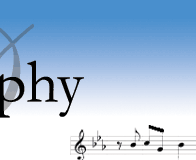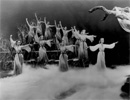


![]()
MY SHINING HOUR - THE GREAT COMPOSER (PART 1)
 Harold
Arlen remained extremely busy in the years after The Wizard of Oz,
not to mention extremely successful! Four months after the release of
The Wizard of Oz in August 1939, M-G-M also released another film
with a score written by Harold Arlen and E.Y. Harburg called At the
Circus. From the movie, which starred the Marx Brothers, came the
comical song entitled Lydia the Tattooed Lady. Then, in
1940, Harold wrote the score for the American Negro Suite with
Ted Koehler. The songs from the show have been heralded as major contributions
to American folk music.
Harold
Arlen remained extremely busy in the years after The Wizard of Oz,
not to mention extremely successful! Four months after the release of
The Wizard of Oz in August 1939, M-G-M also released another film
with a score written by Harold Arlen and E.Y. Harburg called At the
Circus. From the movie, which starred the Marx Brothers, came the
comical song entitled Lydia the Tattooed Lady. Then, in
1940, Harold wrote the score for the American Negro Suite with
Ted Koehler. The songs from the show have been heralded as major contributions
to American folk music.
While he was collaborating with Koehler on the American Negro Suite, Arlen was commissioned to write an instrumental work. At the time, Anya had been studying ballet and so, with his wife in mind, Harold chose to write a piece in the form of a minuet. Titled American Minuet, this work of considerable grace and charm is not very well-known. Though it added to his already sizable professional reputation by demonstrating yet another of his many writing styles, it was not the kind of work that paid the rent.
 So,
early in 1941, Harold returned to Warner Brothers and was assigned to
work with Johnny Mercer on a film script called Hot Nocturne. Of
particular importance was a scene where the hero is tossed into jail with
his friends and a black man in a nearby cell is singing the blues. Harold
was determined to come up with something musically strong and worthy of
a fine voice, so he locked himself in his study and analyzed recordings
of the blues. After two days at it, Harold emerged with a melody. Mercer,
upon hearing it, began inventing lyrical ideas that quickly covered four
pages. Harold admired the lyricist's work and suggested only one change
- that a line appearing on the fourth page be placed at the beginning
of the song. The line was "My mamma done tol' me..." and the
song was, of course, Blues in the Night. It proved impressive
enough to give a new title to the film too; Hot Nocturne became
Blues in the Night. The title song, just like Get Happy,
Stormy Weather, and Over the Rainbow, became
an overnight hit!
So,
early in 1941, Harold returned to Warner Brothers and was assigned to
work with Johnny Mercer on a film script called Hot Nocturne. Of
particular importance was a scene where the hero is tossed into jail with
his friends and a black man in a nearby cell is singing the blues. Harold
was determined to come up with something musically strong and worthy of
a fine voice, so he locked himself in his study and analyzed recordings
of the blues. After two days at it, Harold emerged with a melody. Mercer,
upon hearing it, began inventing lyrical ideas that quickly covered four
pages. Harold admired the lyricist's work and suggested only one change
- that a line appearing on the fourth page be placed at the beginning
of the song. The line was "My mamma done tol' me..." and the
song was, of course, Blues in the Night. It proved impressive
enough to give a new title to the film too; Hot Nocturne became
Blues in the Night. The title song, just like Get Happy,
Stormy Weather, and Over the Rainbow, became
an overnight hit!
On completing the Warner Brothers assignment, Arlen and Mercer moved to Paramount. The movie industry, by early 1942, was geared for war. Service films were ground out regularly, as were all-star musicals. Paramount's biggest all-star musical was Star Spangled Rhythm, for which Arlen and Mercer wrote That Old Black Magic, and Hit the Road to Dreamland.
Their next job was a less impressive one for RKO in 1943. The story was simply about a Flying Tiger pilot on leave, who was charmingly portrayed by Fred Astaire. The film, titled The Sky's the Limit, was not the success the studio hoped it would be. However, two of the songs became tremendous hits. Fred Astaire recalled that "several months [after the film], My Shining Hour became the number-one song of its day and One for My Baby (And One More for the Road) has become a standard classic popular song and one of the best pieces of material that was ever written especially for me." The One for My Baby sequence, staged and choreographed by Astaire, was one of the year's film highlights.
 For
their next pair of films, Arlen and Mercer switched studios again, this
time back to Paramount to write a score for Bing Crosby and Betty Hutton.
1944 and still wartime, Here Comes the Waves was yet another service
film. Work on Here Comes the Waves had reached the point where
inventing just one more song seemed a major impossibility. The songwriters
decided to freshen their views by taking a drive, yet continued to discuss
their work with bleak discouragement. Suddenly, Johnny ask Harold, "How
does that little thing go, I've heard you humming - the spiritual?"
Arlen complied by humming it, but found it difficult to be cheerful. Johnny
brightened with, "You've got to accentuate the positive..."
When Harold sang his melody again, he recognized that Mercer's phrase
clearly fit the music. By the time they had finished their drive, they
had pretty much completed the song. Ac-Cent-Tchu-Ate the Positive
was interpolated into Here Comes the Waves and became a tremendous
hit. The film, on the other hand, was not well received by the critics.
In fact, the New York Tribune found nothing of value in the film but the
songs.
For
their next pair of films, Arlen and Mercer switched studios again, this
time back to Paramount to write a score for Bing Crosby and Betty Hutton.
1944 and still wartime, Here Comes the Waves was yet another service
film. Work on Here Comes the Waves had reached the point where
inventing just one more song seemed a major impossibility. The songwriters
decided to freshen their views by taking a drive, yet continued to discuss
their work with bleak discouragement. Suddenly, Johnny ask Harold, "How
does that little thing go, I've heard you humming - the spiritual?"
Arlen complied by humming it, but found it difficult to be cheerful. Johnny
brightened with, "You've got to accentuate the positive..."
When Harold sang his melody again, he recognized that Mercer's phrase
clearly fit the music. By the time they had finished their drive, they
had pretty much completed the song. Ac-Cent-Tchu-Ate the Positive
was interpolated into Here Comes the Waves and became a tremendous
hit. The film, on the other hand, was not well received by the critics.
In fact, the New York Tribune found nothing of value in the film but the
songs.
The film's reception didn't concern Arlen and Mercer, as the two had already begun work on their next project - a Broadway musical entitled St. Louis Woman. In late summer and autumn of 1945, the team was devoted to work on the new musical. One of its best songs came out of a single evening's work in October. Mercer had come over to the Arlens' and remained in the study while Harold went into the living room and "toyed around with an idea." When Harold played the tune for Johnny, the lyricist liked it and even came up with a fitting opening line, "I'm gonna love you, like nobody's loved you," after which he paused for a moment. Into the brief silence Arlen jokingly injected, "Come hell or high water...," to which Mercer reacted by saying, "Of course, why didn't I think of that - 'Come rain or come shine.'" Before Mercer went home that night, the song Come Rain or Come Shine was complete.
St. Louis Woman opened in 1946, but was not well-received. Ironically, with time, it has been hailed as the Arlen-Mercer masterpiece. The score boasts other great songs like Anyplace I Hang My Hat is Home, I Had Myself A True Love, and I Wonder What Became of Me? After only 113 performances, the show closed on Broadway and Arlen and Mercer returned to California.
 But
Arlen was not a failure on Broadway by any means. While working with Mercer
on Here Comes the Waves, Harold was also busy with E.Y. Harburg
writing a musical entitled Bloomer Girl. The musical touched upon,
among other things, women's rights, slavery, the Civil War and the Underground
Railroad. Songs like Evelina, Right as the Rain,
and slave-song The Eagle and Me are just a few of the greats
to come out of this show. The musical opened in 1944 and was a tremendous
success. Variety magazine stated, "Bloomer Latest Broadway Smash
$20,000 in 1st 4 Shows."
But
Arlen was not a failure on Broadway by any means. While working with Mercer
on Here Comes the Waves, Harold was also busy with E.Y. Harburg
writing a musical entitled Bloomer Girl. The musical touched upon,
among other things, women's rights, slavery, the Civil War and the Underground
Railroad. Songs like Evelina, Right as the Rain,
and slave-song The Eagle and Me are just a few of the greats
to come out of this show. The musical opened in 1944 and was a tremendous
success. Variety magazine stated, "Bloomer Latest Broadway Smash
$20,000 in 1st 4 Shows."
 Harold
went back to writing for films following his layoff from St. Louis
Woman. He first began work on Casbah with lyricist Leo Robin
in 1948. Out of this film came For Every Man There's A Woman
and Hooray for Love. In 1949 he collaborated with Ralph
Blane to write the score for My Blue Heaven. Then, in 1950 he worked
with old pal Johnny Mercer on the film The Petty Girl, out of which
came the song Fancy Free. In 1950-51 he collaborated again
with Ralph Blane to write the score for film Down Among the Sheltering
Palms. Finally, he teamed up with Dorothy Fields twice: once in 1951
on a film called Mr. Imperium and then again in 1952 on The
Farmer Takes a Wife. Although none of these films were terribly successful,
Harold's career continued to shine.
Harold
went back to writing for films following his layoff from St. Louis
Woman. He first began work on Casbah with lyricist Leo Robin
in 1948. Out of this film came For Every Man There's A Woman
and Hooray for Love. In 1949 he collaborated with Ralph
Blane to write the score for My Blue Heaven. Then, in 1950 he worked
with old pal Johnny Mercer on the film The Petty Girl, out of which
came the song Fancy Free. In 1950-51 he collaborated again
with Ralph Blane to write the score for film Down Among the Sheltering
Palms. Finally, he teamed up with Dorothy Fields twice: once in 1951
on a film called Mr. Imperium and then again in 1952 on The
Farmer Takes a Wife. Although none of these films were terribly successful,
Harold's career continued to shine.
< Previous | Top | Next >